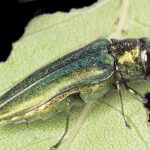James Rada, Jr.
As we move into spring and the trees on Catoctin Mountain and around Northern Frederick County turn green, Thurmont is not overly worried about the devastation caused by the emerald ash borer.
Emerald ash borer is a beetle that is native to eastern and southeast Asia. It was first discovered in the United States in 2002 in Michigan, and it quickly spread from there, appearing in Maryland the following year. The Emerald ash borer is responsible for the destruction of tens of millions of ash trees in 30 states.
“It has about a 98.8 percent mortality rate for ash trees, so you are not going to have any survivability,” Lou Meyer with Davey Tree Experts told the Thurmont Mayor and Commissioners during a town meeting.
When it first appeared in Thurmont, town staff worried that Community Park would be hard hit because it has around 170 ash trees.
“We wanted to avoid losing all the trees, if we could,” said Thurmont Chief Administrative Officer Jim Humerick.
Davey Tree Expert Company was hired in 2016 to start treating the ash trees. It was done with a select group at first, but as the treatment proved effective, more ash trees were treated.
The treatment is a two-step process, with trees being given a pesticide injection one year and a soil booster of pesticides the following year. The two treatments work together to repel the beetle. It continues back and forth until it is determined not to be needed.
“We are seeing a very high success rate with those treatments,” Meyer said.
They have also seen an unexpected benefit.
“Interestingly, some of the trees that aren’t being treated are showing some response as well,” Meyer said.
Since the trees’ root systems connect beneath the ground, apparently, nutrients are getting transferred between trees and providing some residual protection to ash trees that haven’t been treated yet.
While this treatment has been used in different areas, Thurmont is where it has had the greatest success, cutting the mortality rate from 98.8 percent to around 7 percent.
If Thurmont hadn’t started treating its ash trees, Community Park would be looking like a soccer field, according to Meyer, rather than a healthy woodland.
“Until we confirm that there is not a large infestation around us, we are going to keep doing the treatments,” Humerick said. This could be some years yet since Catoctin Mountain is full of untreated ash trees that will feed the beetles and keep them in the area.
The treatments cost Thurmont around $20,000 a year. While replacing dead trees would be cheaper, they would not be fully mature, tall trees like the ones in Community Park. It would take years, if not decades, for replacement trees to truly replace the ones that might be lost.
Luckily, it doesn’t seem residents will have to wait. Community Park is still providing plenty of shade.


